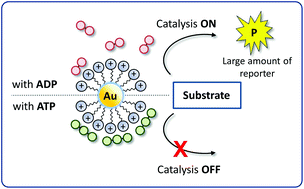Catalytic signal amplification for the discrimination of ATP and ADP using functionalised gold nanoparticles†
Abstract
Diagnostic assays that incorporate a signal amplification mechanism permit the detection of analytes with enhanced selectivity. Herein, we report a gold nanoparticle-based chemical system able to differentiate ATP from ADP by means of catalytic signal amplification. The discrimination between ATP and ADP is of relevance for the development of universal assays for the detection of enzymes which consume ATP. For example, protein kinases are a class of enzymes critical for the regulation of cellular functions, and act to modulate the activity of other proteins by transphosphorylation, transferring a phosphate group from ATP to give ADP as a byproduct. The system described here exploits the ability of cooperative catalytic head groups on gold nanoparticles to very efficiently catalyze chromogenic reactions such as the transphosphorylation of 2-hydroxypropyl-4-nitrophenyl phosphate (HPNPP). A series of chromogenic substrates have been synthesized and evaluated by means of Michaelis-Menten kinetics (compounds 2, 4–6). 2-Hydroxypropyl-(3-trifluoromethyl-4-nitro)phenyl phosphate (5) was found to display higher reactivity (kcat) and higher binding affinity (KM) when compared to HPNPP. This higher binding affinity allows phosphate 5 to compete with ATP and ADP to different extents for binding on the monolayer surface, thus enabling a catalytically amplified signal only when ATP is absent. Overall, this represents a viable new approach for monitoring the conversion of ATP into ADP with high sensitivity.


 Please wait while we load your content...
Please wait while we load your content...